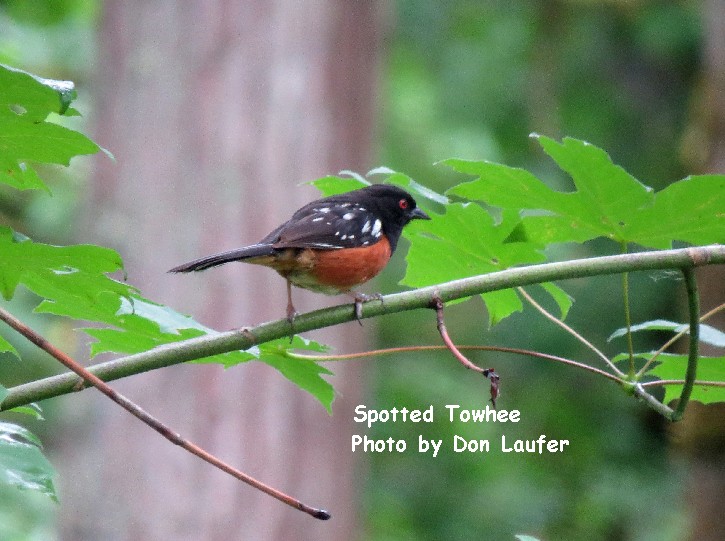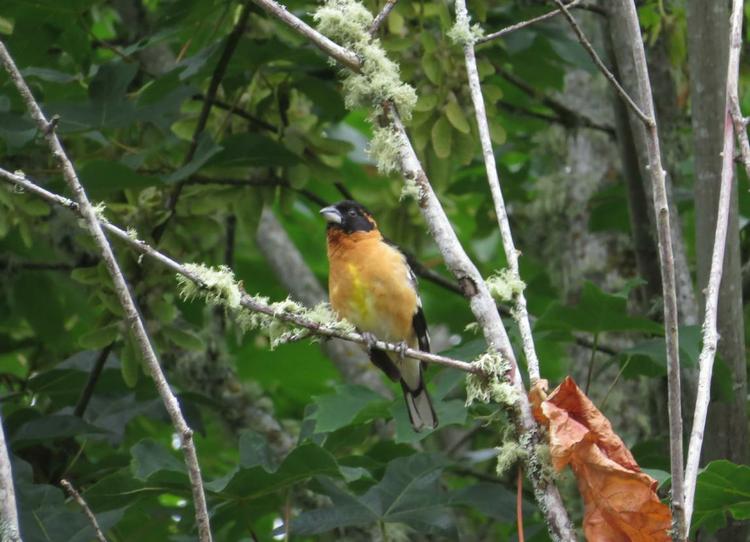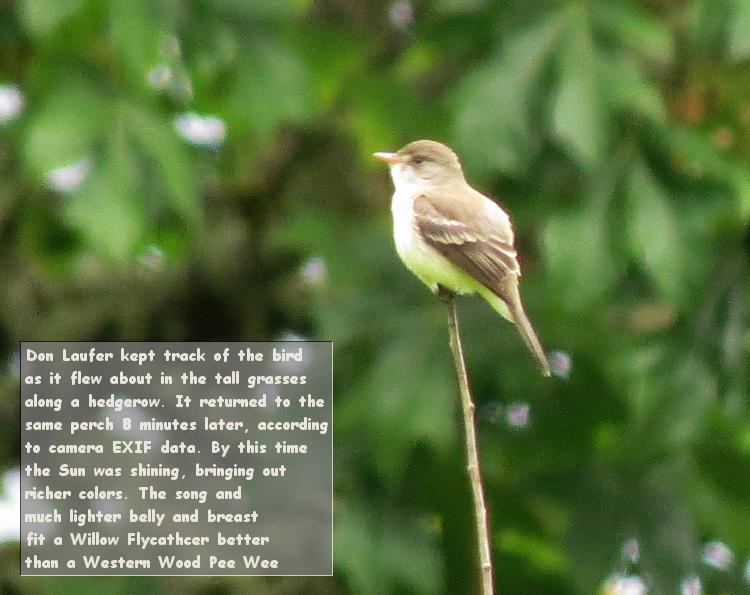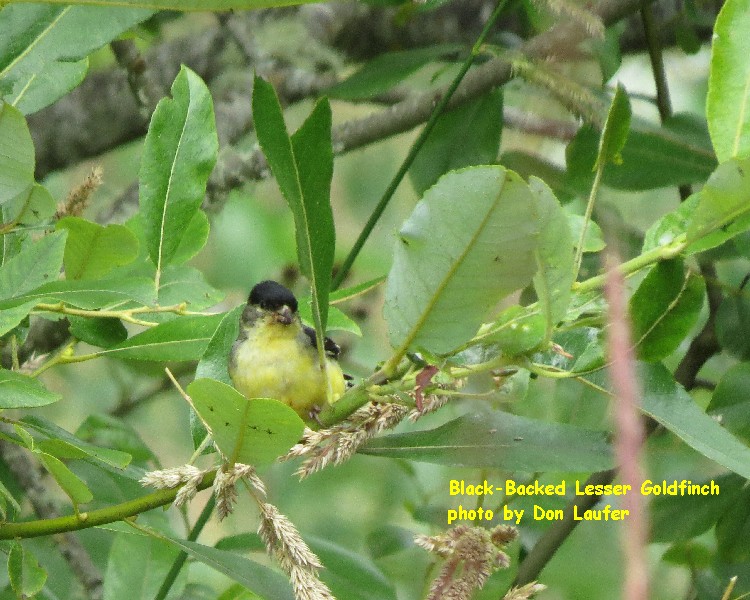Priscilla's
Bird Photography
Photos from personal trips AND trips with
Birds of Oregon and General Science, (BOGS)
in association with Eugene's Celeste Campbell Center
provided by:
Priscilla Sokolowski
Eugene, OR



BOGS Summer Walk 2, Clearwater Landing,
June 26, 2014
BOGS Summer walks in 2014 will be every week. On the 2nd, 4th and 5th Thursdays we will meet at Campbell Center at 9am as per our usual schedule during the Fall, Winter and Spring. On 1st and 3rd Thursdays, we will meet at 8am in the parking area in front of the building because the center is not open before 8am.
I will usually send out an announcement on Tuesday or Wednesday to remind folks about our walk and starting time for that week. Generally I will have an idea about where to go, based on the most recent eBird and OBOL reports of interesting birds in our area. If I have such an idea in mind I will mention it in the emailed announcement. However, I will open up a discussion when we gather for our walk, to see if the group has strong feelings about going some other place.
We have gone on three Summer walks already and have had between 7 and 9 participants each time, with four or five of them being the same core group. This group is very enthusiastic and in no hurry to get back to the Campbell Center. We got back from our Clearwater Landing walk at 1pm. We went to Finley Wildlife Refuge, leaving town at 8am and returned to town at 1:30pm!
Because of this we will take care when arranging car pooling so that those who want to get back to Campbell Center at a certain time can ride together.
I'll just mention at the outset that I do not take many photographs while leading the Summer bird walks because I am much more occupied with bird identification and communicating with everyone present. I always identify photos with an annotation if they are taken by someone else (in most cases these days, Don Laufer). Sometimes I put my name at the bottom right corner of photos I have taken, but quite often photos I have taken have no annotation stating who took them.
Weather: 60 degrees, mostly cloudy skies, from 9:30am to 12:45pm
Seven of us gathered at Campbell Center. Five of us were the same folks as last week, when we had eight. I suggested Clearwater Landing for this walk for several reasons, though none of them compelling; the paved bike path would keep us from mud from recent rains; an owl had been seen in that area the day before; by the Wednesday Morning birding group; and other than the owl, there were no special birds of interest reported in our area in recent days. I suggested we save the Dorris Ranch end of the trail for a day when we might be wanting to avoid being in hot sunshine, so we started at Clearwater landing.
Clearwater Landing Bird List
This is pretty close to the order in which the species were seen
- 10 American Robin
- 5 Tree Swallow
- 6 Spotted Towhee
- 1 Osprey
- 4 Song Sparrow
- 5 Black-headed Grosbeak
- 1 Mallard
- 5 Western Wood-Pewee
- 3 American Goldfinch
- 1 Bewick's Wren (H)
- 1 Mourning Dove (H)
- 1 Great Horned Owl
- 1 Spotted Sandpiper
- 3 Rufous Hummingbird
- 1 American Crow
- 1 Downy Woodpecker
- 1 Willow Flycatcher
- 1 Western Scrub-Jay
- 1 American Crow
- 1 Common Yellowthroat (H)
- 2 California Quail
- 3 Lesser Goldfinch
- 2 Turkey Vulture
When we got there and gathered in the parking lot, I mentioned that we would likely be doing a lot of birding by ear, since we would mostly be walking in wooded areas and the trees had fully leafed out. I thought we might also be faced with trying to identify a few challenging newly fledged young. Last year in June at Skinner Butte we encountered a fledged Spotted Towhee, which had only a few field marks, but just enough to eventually figure it out after getting home. It had the beginnings of some white spots on the wings and white at the bottom of the ends of its long tail, being otherwise an essentially black, Robin-sized bird.
Right away we were treated to a Robin singing in its comparatively languorous manner. I remarked on the slow cadence of the Robin's song, knowing we would certainly be hearing the faster-paced Black-Headed Grossbeak soon enough to notice the difference.


As we walked towards the boat landing, we heard several Spotted Towhees calling; their trill being an especially noteworthy feature. I think overall, we heard more Towhees on this walk than any other species of bird. They were just everywhere!


At the boat landing, Tree Swallows were doing their acrobatic feeding maneuvers over the river and among the trees. An Osprey wound its way in circles over a field and over the river. This turned out to be the only Osprey we saw. Along these lines, we did not see any Bald Eagles; but really we were not near the river hardly at all on this trip, which is where both these species would most likely be seen.
As expected, while we were still at the boat landing, that faster-paced song filled the air. Often you only see the Black-Headed Grossbeak at some distance lurking near the top of a tree, but usually at least partially concealed by leaves. Not so with the bird we were listening to at the boat landing! Not only was he close to us, he was in a bare snag and fully visible only 60 or so feet away.
I always love seeing the play of the colors on the breast and belly of the Black-Headed Grossbeak! This was the first time this year that I've been able to see it really well.




We had several more opportunities to continue comparing the songs of the Grossbeak and the Robin as we continued our walk.
Another bird which we heard in many places on this walk was the Western Wood-Pewee. This bird's call is a single long buzzy note, dropping in pitch slightly. Because this bird so often perches on bare branches, especially out near the ends or tops, and because it returns again and again to the same perch after flying off to get an insect, the Western Wood-Pewee is not difficult to find. The call of this bird was to play an important role near the end of the trip, when we thought we were looking at a Pewee but were NOT hearing this one-syllable call.


Don snapped this beautiful picture of this Cedar Waxwing. Sometimes this bird looks better in the shadows than it does in bright light. So many subtle colors show up.


We heard American Goldfinches often on this walk, but as far as I know, we only saw them once.




About a mile down the trail, there was a wide dirt path branching off to the north. We decided to take this side-path. Don had been on it before and said it winds its way back to bike path again further on.
After walking only 10 feet, I heard a Robin chirping very loud and fluttering from branch to branch in one snag about 70 feet away from us. There was a lot of living vegetation surrounding the snag - lots of leaves. I started scanning up and down the tree for an Owl and was saying out loud to the group to look for an Owl because I'd never seen a Robin so totally beside itself. I no more than finished saying this when I spotted a fledgling Great Horned Owl next to the trunk of the snag-tree on a branch pointing away from us. Some of the others had trouble seeing it for a while, because of how its soft downy feathers molting into darker adult plumage, blended so well with the bark and bare wood and patches of moss on the branch on which it was perched, all of this being further camouflaged or rather obscured by all the foliage between us and the Owl.
Eventually everyone enjoyed good views. Both Don and I got some very nice photos of this owl, what with it being so close to us.
This was the first time I've found an Owl this way, though I've read and heard many times about birds mobbing owls during the daytime?. It was the highlight of the trip for me, that's for sure!




After we finished enjoying the Owl, Christy wanted to continue further so we could get to the river bank and see what we could find there. It was only a short walk. When we got there, Christy scanned across the river and saw a Spotted Sandpiper. It was perched on a fallen tree which had washed down-river with some past storm. Quite far from the shore or even the ground for that matter. There were either two Sandpipers or else the first one moved to a rock at the edge of the current because we spent some time watching one there too. When we see these in Winter they have almost no spots at all on their breasts.
Spotted Sandpiper perched on a log:








On our way back towards where the Owl had been, we saw two California Quail up ahead of us on the bike path. Don said he had been out here a few days before and had seen a family of these in the same general area.


There were some birds which we heard but did not see, and several we saw but did not photograph. Here's a list of them with a brief mention of our sightings.
- Several Bewick's Wrens were heard but not seen, along with quite a few more Song Sparrows, some of which were seen. I tried to take advantage of the opportunity to get better at recognizing each of these by their song, but it seemed like there was just too much variation in each of their songs for me to make much progress.
- Also heard and clearly recognized by most of us, was the call of a mourning dove.
- A Rufous Hummingbird or three flew across the path in front of us along with some other songbird. One of the hummers seemed to hit a flower and lingered there long enough for us to see which species it was.
- At the start of this walk I said I thought we might see some woodpeckers, hopefully including a Red-Breasted Sapsucker, but we didn't see any but one Downy Woodpecker, and even that, only in a later portion of our walk. Around this same time we spotted our first and only two Turkey Vultures.
We saw lots of Western Wood-Pewees, and while the last one we were looking at through Bill and Christy's scope sure did look like a Western Wood-Pewee, it wasn't singing the right song. I kept emphasizing this, (repeating it over and over) because I knew just enough about these Flycatcher's songs to know that a two-syllable "fitz-bew" is a different bird than one that sings a single protracted buzzy note. After leaving its perch and flying around in the grass for about 8 minutes, during which Don tried to keep track of it, the bird finally returned to the same perch again. This time the Sun was out and shining on it and we saw that this bird was lighter in color, especially below, with an almost yellow lower belly. Bill and Christy had taken a walk in this same general area a month ago in a group with Gary Bontrager and that group had seen a Willow Flycatcher. Looking in the books - comparing to our photos, and the voice description - we came to the conclusion that our bird was a Willow Flycatcher. I'd not identified a Willow Flycatcher before.




I am noticing also, only now, that there is no sign in any of these pictures, of the slight crest which gives the Wood-Pewee its characteristic profile.


We could not be absolutely certain that the bird which returned to the perch was the same bird we had been watching before, though at no time did I hear the single note call of a Western Wood-Pewee, yet the two-note "fitz-bew" was being heard both times that the bird was on that perch. Also, if you compare the wing feathers in the area of the wing bars in all these photos, they appear to be equally worn and rounded in the same pattern in all the photos.
ADDENDUM:
I posted these photos to OBOL (Oregon Birders Online) to find out what other birders
would say. From the replies I learned that a critical field mark which separates the Willow Flycatcher
from the Western Wood-Pewee, is how far the wings extend in relation to the tail when the
bird is perched. The Wood-Pewee has longer wings which reach to the middle of the tail,
whereas the Willow Flycatcher's wings stop short right near the base of the tail.
Adding this diagnostic test to the analysis of our bird further confirms
that we were seeing and hearing a Willow Flycatcher. Take another look
at the photos of this bird; you will easily see that the tips of the wing feathers reach only
to the base of the bird's tail.


The Sibley guide, says of the Willow Flycatcher: "Can be mistaken for a Pewee."


Not too long or far from the parking lot on our return trip, the bike path leaves the woods long enough to allow an open area where it crosses the millrace. We heard finches in the streamside bushes and stopped to look them over. They appeared, for the most part, to be Lesser Goldfinches. However, someone noticed something which seemed amiss; at least one of these birds had an essentially all black back, instead of the olive-brown normally seen. I got a good look at it myself. The black cap also extended down in front all the way to the bill. As is common, the throat and breast were brilliant yellow. Jo said the bill was not that of a finch, and she thought the bird to be a warbler. I hadn't had the presesnce of mind to take in the details of the bird's bill, so could not contribute to that line of thought. Don did get a photograph or two, but they were not fully diagnostic. Jo came up with a darker "Arkansas" race of Lesser Finch in her Peterson's guide, and that dove-tailed nicely with some posts which showed up on OBOL that VERY evening. (see further down)




As I mentioned, the very evening after we encountered this dark-backed Lesser Goldfinch,
a birder named Trent Bray posted to OBOL concerning similar birds seen in Union County.
Here are selected portions of his OBOL on the Oregon Birding Association website,
including a citation giving the URL of that posting.
This is followed by another OBOL posting by Mark Nikas,
in which he provides information which Dan Gleason had posted
about this dark-backed variety back in 2007. Again there is a citation
at the end giving the URL of Mark's posting (containing Dan's article) on OBOL.
Birders;
Yesterday (6/25, 4:30 PM), I received a call from La Grande birder,
Michael Wiens. He had phoned to ask if the black backed subspecies of LESSER
GOLDFINCH has occurred in Oregon before, and that he had a very dark-backed
LESSER GOLDFINCH coming to his Thistle Feeder ...
Sibley mentions that the back color of Lesser
Goldfinch varies geographically, with virtually all adult males in southern Texas
having black backs and virtually all adult males west of Colorado and New
Mexico are gree-backed ...
I ran over to Michael's house and together we took a few photos. The best
photos can be viewed:
HERE
In one of my other photos, white shows clearly in the tail, which may
eliminate the black-backed subspecies. This is definitely the darkest
back/auricular colored LESSER GOLDFINCH I have ever seen in Oregon. Anyone have
any experience with dark-backed LESSER GOLDFINCHES outside of Texas?
Good birding,
Trent Bray
CITATION:
http://www.freelists.org/post/obol/Union-County-OR-a-very-blackbacked-male-LESSER-GOLDFINCH
From: Mark Nikas; Date: Thu, 26 Jun 2014 This topic came up on OBOL several years ago and a number of birders reported encounters over the years with black or very dark backed Lesser Goldfinches from various areas around the state. Dan Gleason wrote a good post on the topic that I squirreled away. It's pasted below. Concerning Lesser Goldfinches with black backs, Dan Gleason wrote: I think that we need to keep in mind that this a a species which has not been well studied in comparison to many other species. Dark-backed males apparently do occasionally appear in males of the race of Lesser Goldfinch found in western Oregon. In most instances, these individuals will still show a green tinge around the nape and not be so solidly glossy black as the birds found in Mexico and southern Texas. Both forms occur with greater frequency in the race found in the eastern portion of this species range (Colorado to Texas). More black-backed forms occurr as one proceeds from north to south. This has led some authors to assume that this is a polymorphic species with both color phases occurring in the population, but not everyone goes along with this idea. I don't believe that the genetics of this species has been closely examined so it is hard to know if we are seeing individuals that differ based strictly on genetics or if the variability is caused by other factors. In any event, I would suspect that the birds being seen and reported here, fall with the range of known variability for our race of Lesser Goldfinch (Carduelis pasltria herperophilus). It seems unlikely that southern birds have wandered into Oregon, especially at this time of year. Consider also, that this species is not considered migratory. Some individuals do wander, more so in northern birds than southern populations, and there is some altitudinal movements known that are associated with the seasons. But no long distance movements have been traced. This remains a species about which we still have much to learn. Dan Gleason 7/26/07 CITATION: http://www.freelists.org/post/obol/Union-County-OR-a-very-blackbacked-male-LESSER-GOLDFINCH,2"
Here are a few more photos Don took of our Lesser Goldfinch. In this first one, some of the greenish tinge around the nape and upper back which Dan mentioned, is visible.



